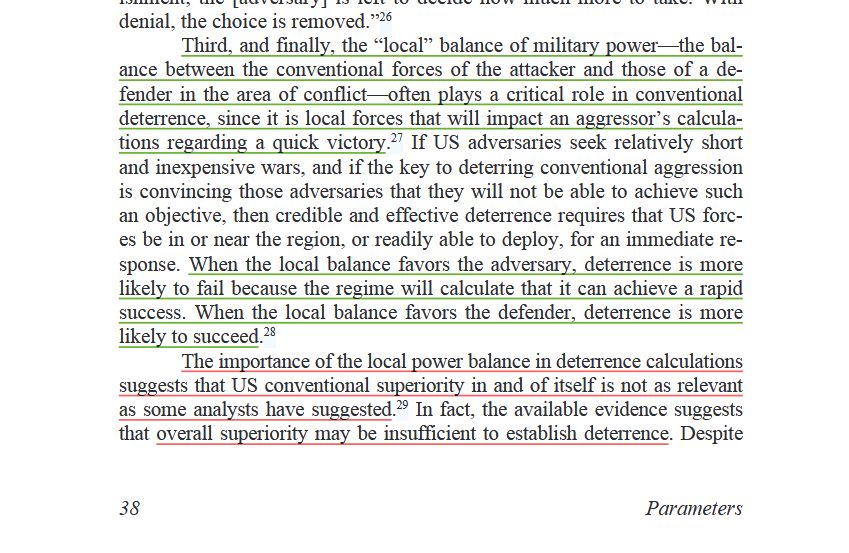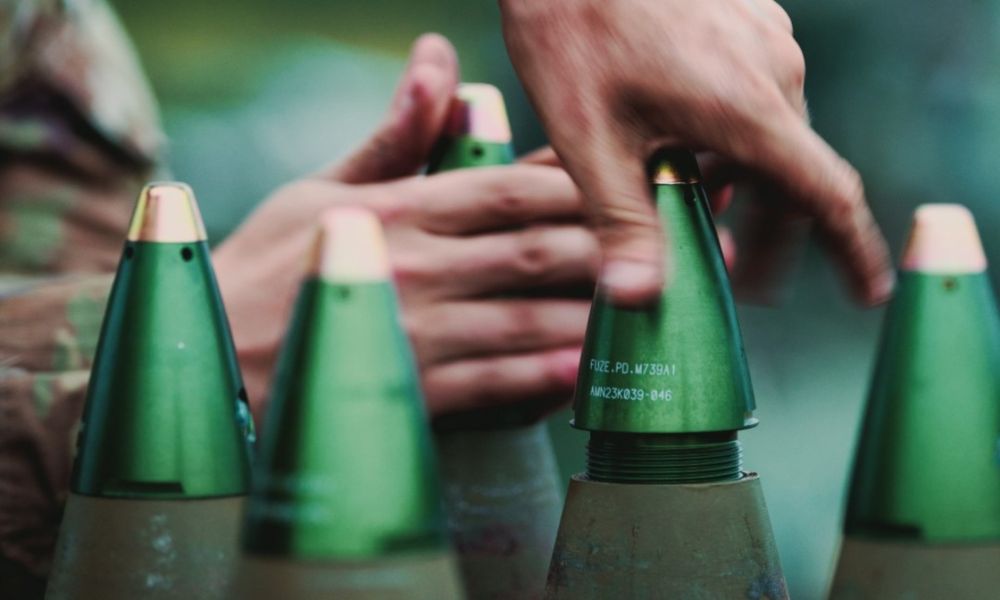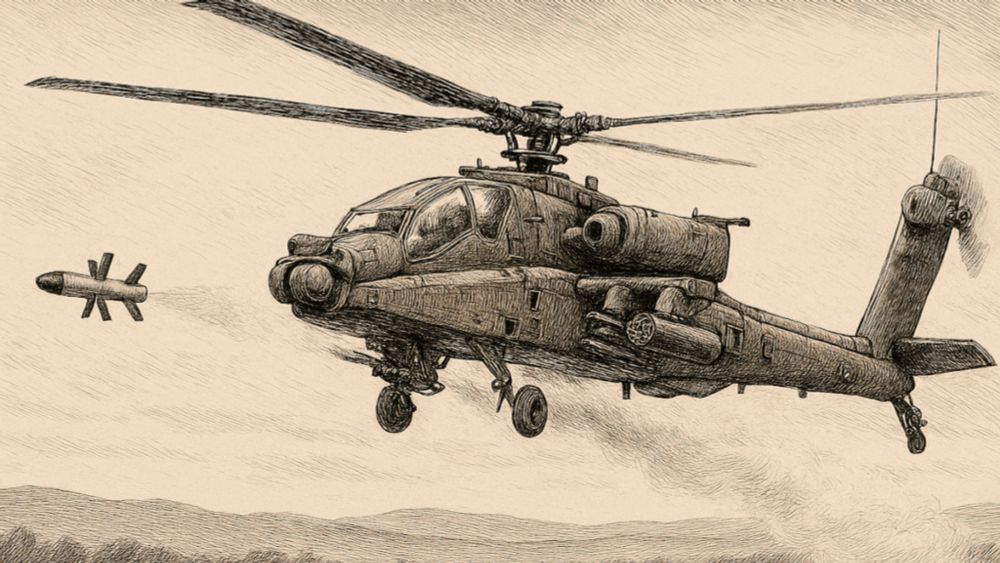
Ukraine’s high-flying air power plans face turbulence
Running fleets of incompatible aircraft creates problems with logistics and pilot training, and Kyiv also faces cash issues.
“If Kyiv succeeds in building a modern air force with more than 200 new Western warplanes, it would wind up operating a mixed fighter jet fleet — something some Western countries are reluctant to do because of the logistical difficulties, as well as issues with training pilots and mechanics.”
23.11.2025 17:41 — 👍 3 🔁 0 💬 0 📌 0
YouTube video by PRIF
Künstliche Intelligenz, Krieg und Kontrolle – Was ist Hype, was echte Gefahr?
Autonome Waffen, Verifikation & Überwachung – wie verändert #KI die globale Sicherheit? @niklasschoernig.bsky.social, @mgoettsche.bsky.social, Andrea Lübcke @gruene.de & Thorsten Wetzling diskutierten am 6.11. mit @erzsewa.bsky.social bei der @berlinscienceweek.bsky.social
20.11.2025 11:09 — 👍 4 🔁 2 💬 0 📌 0

Annotated: the full text of Donald Trump’s 28-point Ukraine-Russia peace plan
Draft agreement has shocked Europe and is unlikely to satisfy Kyiv or Moscow
“The United States and Russia will agree to extend the validity of treaties on the non-proliferation and control of nuclear weapons, including the START I Treaty.” 🤨
21.11.2025 21:35 — 👍 0 🔁 0 💬 0 📌 0

Conventional Deterrence in the Second Nuclear Age
By Michael S. Gerson, Published on 08/01/09
Source: Michael S. Gerson, "Conventional Deterrence in the Second Nuclear Age," Parameters 39, no. 3 (2009), doi:10.55540/0031-1723.2486.
14.11.2025 13:34 — 👍 1 🔁 1 💬 0 📌 0

Third, and finally, the “local” balance of military power—the balance between the conventional forces of the attacker and those of a defender in the area of conflict—often plays a critical role in conventional deterrence, since it is local forces that will impact an aggressor’s calculations regarding a quick victory.27 If US adversaries seek relatively short and inexpensive wars, and if the key to deterring conventional aggression is convincing those adversaries that they will not be able to achieve such an objective, then credible and effective deterrence requires that US forces be in or near the region, or readily able to deploy, for an immediate response. When the local balance favors the adversary, deterrence is more likely to fail because the regime will calculate that it can achieve a rapid success. When the local balance favors the defender, deterrence is more likely to succeed.28 The importance of the local power balance in deterrence calculations suggests that US conventional superiority in and of itself is not as relevant as some analysts have suggested.29 In fact, the available evidence suggests that overall superiority may be insufficient to establish deterrence
“[T]he ‘local’ balance of military power—the balance between the conventional forces of the attacker and those of a defender in the area of conflict—often plays a critical role in conventional deterrence [...] overall superiority may be insufficient to establish deterrence.”
CC @greenpeace.de
14.11.2025 13:34 — 👍 2 🔁 1 💬 1 📌 0

Group of people standing on staircase with publications in their hands

Group of people standing in a courtyard with publications in their hands

Group of people sitting at a long table with microphones

Group of people sitting at a long table with microphones
Last week we presented our new CNTR Monitor “New Realities of AI in Global Security” with stakeholders in political Berlin. Thank you very much to the Federal Foreign Office @diplo.de and the Ministry of Defense, as well as MPs @sarananni.bsky.social and Ralf Stegner for the productive discussions.
12.11.2025 12:18 — 👍 6 🔁 4 💬 0 📌 0

Guns and Ammo: The Ukraine War and NATO’s Ammunition Interoperability Problem - Modern War Institute
If the war in Ukraine has reinforced one truism of modern warfare, it is that artillery remains the king of battle. Its central role in Ukrainian combat operations has been sustained by the commitment...
Highly insightful piece on interoperability: “Sometimes, even STANAG compliance is insufficient to ensure technical interoperability. [...] Ukrainian forces found that they were unable to set the fuzes from a non-US NATO nation with their US-supplied inductive fuze setters.”
11.11.2025 09:35 — 👍 4 🔁 1 💬 0 📌 0
Maybe @niklasschoernig.bsky.social is correct in insisting that we should become proficient in democratic peace theory again.
10.11.2025 12:31 — 👍 2 🔁 0 💬 0 📌 0

The belief that the main cause of war is aggressive states is often linked to the claim that aggressiveness is correlated with, if not caused by, domestic repression. Although for years dismissed if not ridiculed by many arms controllers, this argument receives more than a little support from recent events. It is not likely to be an accident that unprecedented progress in arms control occurred at the same time that the Soviet system first liberalized and then disintegrated. Obstacles which were enormous when Leonid Brezhnev and his predecessors were in power have vanished with Mikhail Gorbachev and the subsequent revolution. This is not to say that all dangers have passed, or that nothing would have been possible without extensive changes within the Soviet Union and its successors, but it does appear that the success of arms control has been driven less by technological breakthroughs, intellectual ingenuity, and shifts in the balance of power than by internal changes which reconstructed the Soviet and post-Soviet polity.
“It is not likely to be an accident that unprecedented progress in arms control occurred at the same time that the Soviet system first liberalized and then disintegrated.”
Jervis, Robert. “Arms Control, Stability, and Causes of War.” Political Science Quarterly 108, no. 2 (1993): 239–53.
10.11.2025 12:29 — 👍 2 🔁 1 💬 1 📌 0

Attack Helicopters Must Hunt the Hunters
“Bingo” means the point of no return: the call that fuel is running dry and the mission is over. The same call now threatens the attack helicopter itself.
“Suppression of enemy air defenses should become a core competency for American attack helicopter pilots. [...] Without the capability to conduct their own suppression of enemy air defenses in support of their primary missions, helicopters will watch the next war from the sidelines.”
09.11.2025 15:22 — 👍 0 🔁 0 💬 0 📌 0
🚄 Im ICE mit 40 Minuten Verspätung: „Es tut mir leid, Sie heute wieder in diesem Maße herausfordern zu müssen.“
07.11.2025 19:58 — 👍 1 🔁 0 💬 0 📌 0

Image shows the cover of the CNTR Monitor 2025 with the title "New Realities of AI in Global Security" and the text: CNTR Monitor 2025 - Focus. How artificial intelligence impacts global security: Geopolitics of chip production. AI 'arms race' talk. AI in the military. AI developments in... Biotechnology, Chemistry, Verification. Published on November 6, 2025.
The new CNTR Monitor is here!
We take a look at technological trends with an impact on peace and security. The first half is dedicated to this year's focus topic, “New Realities of AI in Global Security”.
Read online or download here: monitor.cntrarmscontrol.org/en/2025/
#openaccess
06.11.2025 08:37 — 👍 9 🔁 8 💬 0 📌 0

Wir müssen KI-Regulierung neu denken
Bisherige Ansätze in der Rüstungskontrolle könnten nicht mit dem Innovationstempo von KI mithalten, schreiben die Forscher Kadri Reis und Malte Göttsche. Deshalb empfehlen sie hier und ab Donnerstag i...
KI schafft neue Realitäten in der internationalen Sicherheit. Warum wir deshalb KI-Regulierung neu denken müssen, schreiben @k3kr.bsky.social und @mgoettsche.bsky.social in einem Gastbeitrag für @table.media (€) – und geben dabei einen Ausblick auf den neuen CNTR Monitor, der am 6.11. erscheint.
05.11.2025 08:22 — 👍 8 🔁 8 💬 0 📌 0

In rain and mud, French artillery unit shows lessons from Ukraine war
The demonstration showed how France’s 35th Parachute Artillery Regiment is trying to adapt to a drone-dominated battlefield.
“A French Army artillery demonstration in pouring rain in the south-east of the country last week showed the limits of modern warfare: When the weather gets miserable, cannons may still fire, but drones stay grounded.”
03.11.2025 07:53 — 👍 2 🔁 2 💬 1 📌 0
Reuters: "A military source said a [ground-launched] 9M729 fired by Russia on October 5 flew over 1,200 km to its impact in Ukraine."
Exclusive: Russia uses missile in Ukraine that led Trump to quit nuclear treaty [in 2019], Kyiv says www.reuters.com/business/aer...
31.10.2025 11:25 — 👍 6 🔁 2 💬 1 📌 1
A great overview on the use of additive manufacturing in the military technology sector by @liskasuckau.bsky.social. 👇
31.10.2025 08:10 — 👍 3 🔁 1 💬 0 📌 0

Why NATO needs a new nuclear strategy
Opinion: A modern NATO nuclear strategy does not require reinventing the wheel, writes German defense analyst Karl-Heinz Kamp.
“[N]uclear targeting would focus primarily on Russian territory and probably on Belarus but no longer – as in the Cold War – on NATO terrain.”
At the same time, this makes the risk of rapid escalation even more likely than during the Cold War...
31.10.2025 08:00 — 👍 0 🔁 0 💬 0 📌 0

Stack of boxes with some publications stacked on top of it, the publications have a blue and red cover with a photo of a landscape on it and the title "CNTR Monitor 2025"
Fresh off the press: The new CNTR Monitor will be published on November 6. This year we focus on AI and its impacts on global security: how it's used in the military, dual-use risks of AI applications in biotechnology and chemistry, but also opportunities for verification. Stay tuned!
27.10.2025 12:51 — 👍 6 🔁 6 💬 0 📌 0
“European Long-range Strike Approach (ELSA)” 😬
27.10.2025 08:35 — 👍 4 🔁 0 💬 0 📌 0
Global Society is a journal of international studies published by Taylor & Francis. Editors: Rubrick Biegon, Tom Casier, Hendrik Huelss, Melita Lazell, Alexandre Christoyannopoulos, Peter Marshall
https://www.tandfonline.com/toc/cgsj20/current
The Society for Historians of American Foreign Relations
est. 1967
#SHAFR2026 - The Ohio State University - June 25-27, 2026
My book is here: https://amzn.to/4noUdTy
Offisiell konto for Forsvarets høgskole. Official account for the Norwegian Defence University College
https://www.forsvaret.no/om-forsvaret/organisasjon/FHS
Senior researcher @prif.org @cntrarmscontrol.org @cbwnet.org
Biological and chemical weapons disarmament // governance of dual-use research // biosecurity // emerging tech and CBW
International security scholar working on alliances and military adaption. Core faculty Georgetown SSP & NonRes Snr Fellow Scowcroft Center Atlantic Council
MTA is the primary nuclear policy research project at @Belfercenter.bsky.social, @Harvardkennedy.bsky.social.
Repost ≠ endorsement.
Adjunct Fellow, Center for a New American Security | PhD student at American University SIS | Transatlantic Russia policy | European integration | International norms & institutions | Duke and GeorgetownSFS alum | https://nicholaslokker.com/
ISPK is a research institute affiliated with the University of Kiel. We focus on maritime strategy & security, terrorism & radicalization research, conflict studies & hybrid warfare, and Asia-Pacific security.
www.ispk.org
www.kielseapowerseries.com
Host @crisisroompod.bsky.social writes for Sunday Times, ex-BBC guy covering war & peace + sometime Newsnight presenter 1990-2024, IWM trustee, author Big Boys Rules, Generals, Rifles, Task Force Black, The Tank War, Skripal Files, Red Devils, Tank & more!
European Defence Editor at Aviation Week, proud hubby to Dr Kubi, aircraft photographer (Canon user, obvs), and #RIAT volunteer among other things.
Ph.D., Pol. Magister, Dipl. VW
Senior Researcher @hsfk_prif
Emerging Military Tech, Democracy and War, Old-School Arms Control. IR Liberal
(Co)Head of reseach group @CNTRArmscontrol #SGE
"social justice worrier" (nach Stephen Fry) 🎗️
CSP publishes theoretically-based research on policy problems of international security.
It encourages novel contributions, not particular methodologies or policy goals.
Our aspiration: 🌎🌍🌏
Editors: Myriam Dunn Cavelty, Nicole Jenne, Yf Reykers
Father, husband, citizen, professor, focusing mainly on nuclear weapons and nuclear energy issues. Faculty lead for Harvard's Managing the Atom project: www.belfercenter.org/programs/managing-atom
My website: matthewbunn.scholars.harvard.edu
Professor of Political Science, University of Copenhagen. Research interests: European and Nordic Politics, Political Economy. Collector of modern ceramics, Faroese paintings and Christine Swane paintings. Lifelong fan of Bob Dylan and modernist poetry.
Finishing a PhD in nuclear history @ University of Marburg / Working on arms control and military strategy @ifshhamburg.bsky.social.
Private account.
https://www.hamburg-armscontrol.de/en/staff/lukas-mengelkamp-2/
Prof. of Political Science, @uniinnsbruck.bsky.social | Director, https://foreignpolicylab.at/ | Lecturer, Diplomatic Academy Vienna | interest in international order, AUT Foreign Policy (https://www.neutralitaet.info/), political communication, nukes
General Counsel and Senior Editor at Lawfare. Fellow at the Brookings Institution and Columbia Law School. Former diplomat and lawyer.
Writer on Civil-Military Relations - NATO - Political History - Central and Eastern Europe
PhD from King’s College London Department of War Studies
Check out my podcast and substack Official Positions!
Big into X-Files and Twin Peaks references 🛸🦉☕️
Non-Resident Senior Fellow at Atlantic Council/ Prof at U of Mary Washington
Research on NATO/ Transatlantic Security
Racing cyclist


























